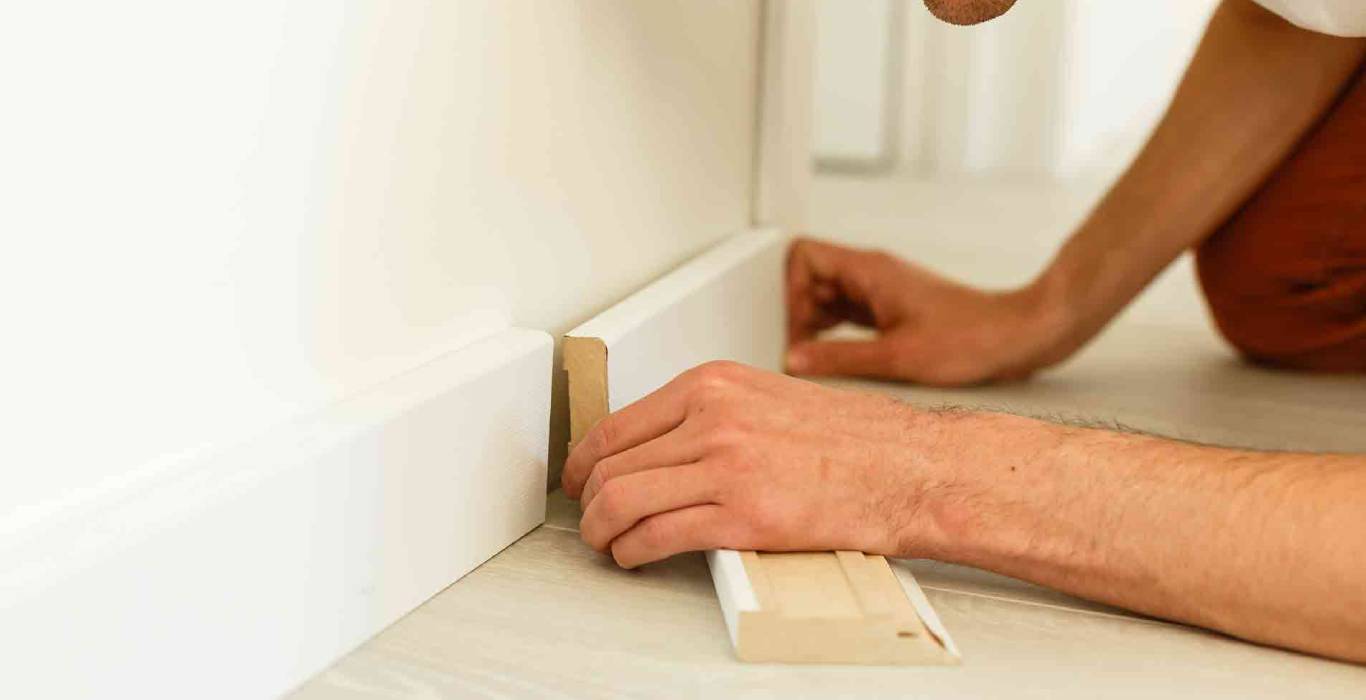Skirting boards, also known as baseboards or skirting, are architectural elements that are installed at the bottom of interior walls where they meet the floor. They serve both functional and decorative purposes in space.
What Are the Key Features of Skirting Boards?
- Protection: Skirting boards protect the bottom portion of walls from scuffs, abrasions, and impact damage caused by furniture, vacuum cleaners, and other objects. They act as a barrier, shielding the wall surface from wear and tear.
- Concealment: Skirting boards help conceal gaps and uneven joints between the wall and floor. They provide a finished, cohesive appearance, covering any unsightly gaps or imperfections due to uneven floorings or irregularities in wall construction.
- Transition: Skirting boards provide a smooth transition between different materials, such as the junction between different types of flooring, like hardwood and carpet or tile and laminate. They create a visually pleasing boundary, ensuring a neat and polished look.
- Wiring and Cables: Skirting boards often have a hollow space behind them that allows for the discreet installation of electrical wiring, cables, or other services. This conceals the wiring while allowing for easy access and potential future modifications.
- Design and Aesthetics: Skirting boards contribute to the overall design aesthetic of a space. They come in various materials, styles, and finishes, allowing customisation to match the interior design scheme. Skirting boards can be simple and understated or ornate and decorative, depending on the desired look.
- Acoustic and Thermal Insulation: Skirting boards provide minor acoustic and thermal insulation. They help reduce noise transmission between rooms and act as a barrier to prevent drafts or heat loss between the wall and floor.
- Easy Maintenance: Skirting boards are relatively easy to clean and maintain. They can be wiped down or vacuumed to remove dust and dirt, providing a clean and tidy appearance to the lower portion of walls.
Choosing Skirting Designs
Several factors must be considered when deciding on skirting designs for your space. Here are some key considerations:
- Architectural Style: Consider the architectural style of your space. Skirting designs should be compatible with the overall design aesthetic. For example, suppose you have a traditional or classic interior. In that case, you may opt for ornate and decorative skirting profiles, while a modern or minimalist space may call for clean and simple skirting designs.
- Proportions and Scale: Consider the room’s proportions and scale. The height and width of skirting boards should be proportionate to the space’s size and the walls’ height. Larger rooms with higher ceilings may accommodate taller skirting boards, while smaller rooms may benefit from narrower profiles.
- Material and Finish: Consider the material and finish options for skirting boards. Common materials include wood, MDF, PVC, and metal. Each material comes with its own aesthetic appeal and maintenance requirements. Choose a material and finish that complements the overall design scheme and matches your desired level of durability and maintenance.
- Design Cohesion: Ensure the skirting design complements the space’s other architectural and design elements. Consider the flooring material, door and window trim, crown moulding, and other decorative features. The skirting design should create a cohesive and harmonious look that ties all these elements together.
- Personal Preference: Your preference and style play a significant role in selecting skirting designs. Consider your individual taste, whether you prefer more traditional, ornate designs or modern, streamlined profiles. The skirting design should align with your personal aesthetic vision and create a space that you find visually appealing.
- Practical Considerations: Think about the practical aspects of skirting designs. Consider ease of cleaning and maintenance. Some skirting profiles may have intricate details that are more challenging to clean, while others may offer a smoother surface. Additionally, consider the placement of electrical outlets and switches and how the skirting design can accommodate their positioning.
- Budget: Set a budget for skirting designs and consider the cost implications. Different materials and designs can vary in price, so choosing options that fit your budget is essential. Balancing cost with the desired aesthetic and quality is crucial.
- Long-Term Durability: Consider the durability of the skirting materials and their resistance to wear and tear. Some materials may be more prone to damage or require more frequent maintenance. Choose skirting designs that are durable and can withstand the demands of daily use.

Does the Size of Skirting Boards Matter?
The size of skirting boards does matter and can impact a space’s overall appearance and functionality. Here are some factors to consider regarding the size of skirting boards:
- Proportions: The size of skirting boards should be proportionate to the size of the room and the height of the walls. In larger rooms with higher ceilings, taller skirting boards can create a sense of grandeur and balance the vertical space. On the other hand, in smaller rooms or spaces with lower ceilings, narrower skirting boards can help maintain a sense of proportion and avoid overwhelming the room.
- Visual Impact: The size of skirting boards can influence their visual impact in a space. Larger skirting boards can create a bolder and more prominent look, drawing attention to the base of the walls and adding a sense of architectural detail. On the other hand, smaller skirting boards can provide a more subtle and understated finish.
- Design Style: Consider the design style of the space when selecting the size of skirting boards. Different design styles may call for different skirting board sizes. For example, taller and more elaborate skirting boards are often used in traditional or classic interiors to enhance the ornate aesthetic. Smaller and simpler skirting boards may be preferred in modern or minimalist interiors to maintain a clean and streamlined look.
- Functionality: The size of skirting boards can also impact their functionality. Taller skirting boards provide better wall protection against furniture bumps, vacuum cleaner impacts, and general wear and tear. They can be a more effective barrier between the walls and the floor. However, ensuring that the skirting boards do not interfere with furniture placement or cover essential outlets or switches is essential.
- Personal Preference: Ultimately, the size of skirting boards should align with your personal preference and the overall design vision for the space. Consider what visually appeals to you and what fits your desired aesthetic. Consider the other design elements in the room and how the size of the skirting boards will contribute to the overall look and feel.

Frequently Asked Questions About Skirting Boards.
What materials are skirting boards made of?
Skirting boards can be made from various materials, including wood, MDF (medium-density fiberboard), PVC (polyvinyl chloride), and even metal. Each material comes with its own aesthetic appeal and maintenance requirements.
What are the benefits of installing skirting boards?
Skirting boards protect walls, conceal gaps between walls and floors, enhance design aesthetics, create transitions between different materials, and offer a finishing touch to a space. They can also help with the discreet installation of wiring and cables.
How do I choose the right skirting board size?
Choosing the right skirting board size depends on factors such as the room’s size, the walls’ height, and the overall design style. Larger rooms with higher ceilings can accommodate taller skirting boards, while smaller rooms may benefit from narrower profiles. Proportions and personal preferences should also be considered.
How do I install skirting boards?
Skirting boards are typically installed using adhesive or nails. The installation involves measuring and cutting the skirting boards to size, ensuring a level installation, and securing them to the wall. It is recommended to consult professional installers or follow manufacturer instructions for proper installation techniques.
Can skirting boards be painted?
Yes, skirting boards can be painted to match the desired colour scheme of a room. Wood skirting boards can be stained or painted, while PVC or MDF skirting boards often come pre-finished and can be painted if desired.
How do I clean and maintain skirting boards?
Skirting boards can be cleaned by wiping them with a damp cloth or using a mild cleaning solution. Regular maintenance involves dusting and removing any accumulated dirt or grime. Different materials may require specific cleaning and maintenance techniques, so following manufacturer guidelines is essential.
Can skirting boards be removed or replaced?
Skirting boards can be removed or replaced if needed. However, this may require careful removal to avoid damage to the walls or floorings. Consulting professionals or following proper removal techniques is recommended to ensure a smooth process.
Do skirting boards affect room acoustics?
While skirting boards do not significantly impact room acoustics, they can contribute to reducing noise transmission between rooms when combined with other soundproofing measures, such as insulation or acoustic treatments.
Can skirting boards be used in wet areas like bathrooms?
Certain materials, such as PVC, are suitable for use in wet areas like bathrooms due to their water-resistant properties. However, it is essential to choose appropriate materials for the specific environment and follow installation guidelines to prevent water damage.
Remember, it’s always a good idea to consult with professionals or suppliers for specific advice and recommendations regarding skirting boards based on your unique requirements and circumstances.
 01322 470 300
01322 470 300



